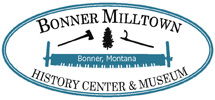This virtual interpretive center honors the rich and diverse history of the two rivers where for thousands of years nature, humans, and politics have intertwined at the confluence of the Big Blackfoot and Clark Fork Rivers. It also builds on more than three decades of local history preservation efforts.
In 1975, two individuals spearheaded projects that forever set the standard for historic preservation in the Bonner area. Gladys Peterson, Bonner School fifth grade teacher, responded to a question posed by Jack L. Demmons, superintendent and Piltzville native, about how to use some extra funds available through the PTA. Peterson’s answer: “We need a Bonner history.”
Peterson organized teachers, community members, and friends to produce A Grass Roots History: The Story of Bonner, Montana, published by the Bonner. Demmons began collecting historic photographs and continued long after the April, 1976 dedication of the book. The book encompassed the history of the greater Bonner area from Pine Grove to Milltown to Piltzville, and collected the memories of individuals now passed away. The photos have been digitized and are available to the public through the University of Montana Archives.
This book and collection of 1600 photos were also essential to meeting the historical assessment requirement for the Environmental Protection Agency’s (EPA) mitigation of arsenic pollution in the Milltown Reservoir. The remediation also provided an important professional assessment of the reservoir site and each structure in Milltown as well as an historic assessment of the mill site and Bonner dam before its removal in November, 2005.
In the Consent Decree, the legal agreement pertaining to the Milltown cleanup, historic mitigation funds were set aside specifically to preserve Milltown Dam Powerhouse artifacts and documents, and the Demmons Collection of historical photos. Other money was set aside to preserve the history of the Bonner mill dam.
As the Milltown Redevelopment Working Group carried out the mandates of the Consent Decree, local residents formed the Bonner Area History Roundtable (BAHR), an informal group which met to recount and continue to record stories of local history.
With the sale of the Bonner company houses and closing of the mill, new historic preservation projects began. The Montana Improvement Company purchased the Bonner houses and funded the research for the nomination to make Bonner a National Historic District. As of 2009, that decision is pending National Park Service approval. BAHR is seeking a grant to collect additional oral histories and continue the photo collection begun by Jack Demmons 35 years ago. Space for a local history center has been donated the Montana Improvement Company in the historic “Roundhouse” building. Watch for the opening and bring your memories!
This website continues the work of telling and interpreting the many stories of the confluence begun decades ago by Peterson and Demmons.
